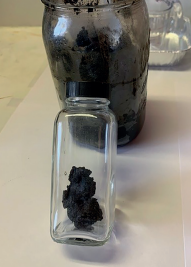HydroCarbon Solutions’ tank cleaning technology generates useable oil from tank sludge
Born in oilfields of West Texas back in 2004, HydroCarbon Solutions (HCS) has been cleaning aboveground storage tanks one at a time for the past 17 years. Bringing environmentally friendly technology and non-person entry to the hazardous job of crude oil tank deposition cleaning, HCS has seen the demand for their services double in that time.
ASSET RECOVERY TECHNOLOGY
The tank cleaning fluid used by HCS un-bonds the paraffin wax by converting it back into liquid oil which can be more easily removed. HCS has products for oil wells, pipelines, storage tanks and barges. The technology can mitigate risks to both the environment and onsite personnel, while recovering lost revenue for crude oil asset owners and operators. The tank cleaning technology is the result of 20 years of work on hydrocarbons and waxes by HCS chemists.
HCS believes that its tank cleaning technology is the easiest and most effective way to generate additional revenue from crude oil sludge, as it converts it back into an on-spec crude which is ready for market. The technology has been tested by several major oil company laboratories, which have found no adverse effects on the base crude oil or equipment such as storage tank liners.
OPPORTUNITIES FOR PROFIT
HCS has found that owners and operators of oil wells, storage tanks, barges, or pipelines which use its technology
can profit from the process, as the value of the newly recovered crude oil is far higher than the initial cost of using any of the treatments.
HCS estimates that typically, for every US$1 spent on a chemical treatment there will be a return of US$5-8 in saleable crude oil, depending on market prices. For most tank farms, the savings are in tank cleaning costs, and HCS estimates that for every US$1 (€0.85) spent on the cleaning chemicals, a tank farm will save US$3 in cleaning expenses. The cleaning process can take as little as one month.
APPLICATIONS
Oil wells
The HCS process can be used to treat paraffin downhole to eliminate hot oiling. The treatment saves on heating oil and then flashing off the light ends. HCS developed a paraffin treatment that saves time and cost, keeps the rods clear of paraffin, and migrates downstream to keep everything flowing. Valves and provers work more efficiently as well.
Storage tanks
The HCS process offers a unique solution to accumulated crude oil tank bottoms. This means limited hazardous substances need to be extracted after the process is complete and no personnel need enter the tank until after the hazardous material is gone. HCS cleaning fluids are added to the tank and mixed, and the newly-converted oil can be sold. The tank can be returned to service if this is a preventative maintenance exercise, or prepared for full API 653/EEMUA 159 tank inspection.
Pipelines
HCS has been optimised for the treatment of asphaltene and paraffinic wax in oil pipelines. Small amounts of HCS can be added to keep pipelines free of asphaltene and paraffinic wax build-up. The process maintains the internal diameter of the pipe, thus maximising design flow rates, by reducing pipeline drag, and avoiding costly out-of-service time. This is more prevalent in some older oil field operations where the reservoir temperature has dropped. The build-ups of asphaltene and paraffinic wax means that operators must increase the frequency of pigging, which can be a costly exercise. HCS offers a low freeze point pipeline cleaner suited to low temperature installations
Crude oil barges
HCS cleaning technology is suitable for use in crude oil barge compartments. When a small quantity of the product is added to the crude oil cargo, it will homogenise with the asphaltene and paraffinic wax in-transit to its home port by the natural agitation of the waves. This enables the extraction of asphaltene and paraffinic wax as a saleable product at the destination port.
HOW IT WORKS
HCS works by restoring fluid characteristics to high-viscosity crude oil sludge, separating the contents into three-phases: the constituent crude oil, water, and inorganic solids, such as sand, grit and metals (BS&W).
Paraffin is an alkane hydrocarbon with the general formula (CnH2n+2). Paraffin or paraffinic petroleum derivatives include paraffin oils and paraffin wax. Paraffin wax consists of alkane mixture where chain length ranges from 20 ≤ n ≤ 40 range. The hydrocarbon chains are found in both straight and branched forms. As the temperature of certain crude oils drops and reaches the pour point wax crystals start to appear and become solid at
room temperature.
These aromatic hydrocarbons are important because they prevent the crude’s larger, straight-chain hydrocarbons from interacting with one another and forming Van der Waal bonds. These bonds lead to the larger molecules clumping together, ultimately leading to an increase in viscosity and the formation of waxes and asphaltenes – or sludge.
Unlike the aromatic hydrocarbons, the HCS additive is not itself volatile. It has a flash point of 97°C, meaning it remains in the crude without evaporating, preventing the formation of the long-chain hydrocarbon clumps that lead to sludge deposits. In short, HCS mimics the behaviour of the lost aromatic components of the crude, but without evaporating at normal atmospheric temperatures, so the paraffinic wax does not reappear.
For more information:
Contact HydroCarbon Solutions for more information or to arrange a free consultation.
Jack McLean at jmtankman@gmail.com or +1 506-962-3064
Chris Hastings at chrisfhastings@icloud.com or +1 832-392-7158
www.hydrocarbon-solutions.com











